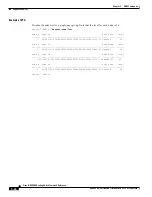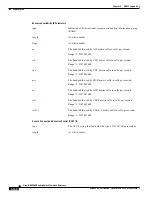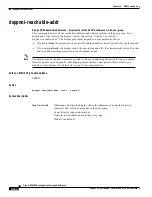
5-94
Cisco MGX 8850 Routing Switch Command Reference
Release 2.0, Part Number 78-10467-04 Rev C0, October 2001
Chapter 5
PNNI Commands
dsppnni-ptse
dsppnni-ptse
Display PNNI topology state element
—
displays PTSE tables.
The dsppnni-ptse command displays PNNI topology state elements (PTSEs). The purpose of this
command is troubleshooting, and it requires familiarity with the ATM Forum PNNI 1.0 specification.
Without knowledge of this specification, the usefulness of dsppnni-ptse is minimal.
PTSE Types
A node indicates its characteristics (such as all its ATM addresses) to all other nodes in the peer group
by broadcasting numerous PTSEs. A node periodically sends (or floods the group with) PTSEs according
to a user-specified timer but also floods the group with PTSEs when it triggers a change of topology. A
typical topology change is an addition of an ATM address.
Each PTSE carries an indicator of what type of PTSE it is. This PTSE type appears as both a descriptive
string and a number set by the ATM Forum. The section, “
Display Contents for dsppnni-ptse
” lists the
contents of each information group identified by the PTSE type. Five basic types exist, and various
subtypes exist. The basic types of PTSEs are:
1.
Nodal information group
2.
Internal reachable addresses
3.
External reachable addresses
4.
Horizontal links
5.
Uplinks (multiple peer groups only)
Granularity of the Output
The optional parameters let you determine the granularity of the target of the command. The granularity
ranges from the whole peer group to a specific logical port. Additionally, you can specify a “detailed”
display or just the header information for PTSEs.
If you specify:
•
Nothing, the display contains header information for all PTSEs for all logical nodes in the network.
•
Only the node-index, the output contains all PTSEs sent from the node indicated by node-index.
•
Only node-index, node-id, and ptse-id, the display shows the PTSE uniquely identified by these
three parameters.
•
A detailed display, the display contains information about the header and the contents of the PTSE
and applies to all combinations of the other parameters.
Note
The node-index is automatically generated. See description of dsppnni-node-list.
The ptse-id is generated by the node that sends the PTSE.
You can use dsppnni-ptse to trouble-shoot a faulty designated transit list (DTL). If a DTL is faulty, you
can observe the PTSE of nodes on the designated path to confirm the accuracy of the information used
to build the DTL. You can also use dsppnni-ptse to determine if nodes are correctly passing both the
topology packets and the Hello packets.
















































